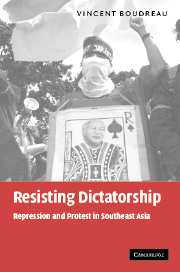Book contents
- Frontmatter
- Contents
- List of maps
- Acknowledgments
- List of abbreviations
- 1 Introduction
- 2 Protest, repression and transition in Southeast Asia
- 3 Authoritarian attack and dictatorial rise
- 4 Protest in socialist Burma
- 5 New Order repression and the Indonesian opposition
- 6 The Philippine new society and state repression
- 7 Repression and protest in comparative perspective
- 8 People power and insurgency in the Philippine transition
- 9 Protest and the underground in Burma
- 10 Indonesia's democracy protests
- 11 Democracy protest and state repression
- List of references
- Index
10 - Indonesia's democracy protests
Published online by Cambridge University Press: 15 December 2009
- Frontmatter
- Contents
- List of maps
- Acknowledgments
- List of abbreviations
- 1 Introduction
- 2 Protest, repression and transition in Southeast Asia
- 3 Authoritarian attack and dictatorial rise
- 4 Protest in socialist Burma
- 5 New Order repression and the Indonesian opposition
- 6 The Philippine new society and state repression
- 7 Repression and protest in comparative perspective
- 8 People power and insurgency in the Philippine transition
- 9 Protest and the underground in Burma
- 10 Indonesia's democracy protests
- 11 Democracy protest and state repression
- List of references
- Index
Summary
1998 Indonesian democracy protests marked an important break with established patterns, in which state policies scattered and fragmented all opposition movements (apart from those operating in insurgent areas like East Timor and West Papua). Although sustained national protest took almost a decade more to mobilize, keterbukaan in the 1980s paved the way for this movement. On a number of important fronts, long-standing restrictions on political activity relaxed, and activist institutions like the student press or independent unions revived. By the early 1990s, the regime's ability to suppress political organization began to slip. Some of the more radical local struggles, such as the Kedung Ombo Dam campaign, produced (tentative) national coalitions among LSMs. Legal aid groups, particularly Lembaga Bantuan Hukum (LBH, Legal Aid Foundation) adopted a structural approach that systematically opposed regime policy and built a national network. Incarcerated student leaders in the late 1980s met and learned from members of the comparatively well-organized East Timorese independence movements, and after, began thinking more seriously about organizational styles and secessionist movements.
Keterbukaan encouraged activists more extensively to utilize electoral opportunites and institutions. In 1987, under Suryadi's new leadership, the Partai Demokrasi Indonesia (PDI, Indonesian Democratic Party) gradually sharpened its opposition, recruiting members of the Sukarno family to draw on the first president's charismatic legacy, and attracting in consequence young activists seeking new venues for dissent. Somewhat unrealistically, Suryadi strove both to play by the regime's rules and expand the PDI's power.
- Type
- Chapter
- Information
- Resisting DictatorshipRepression and Protest in Southeast Asia, pp. 215 - 237Publisher: Cambridge University PressPrint publication year: 2004



